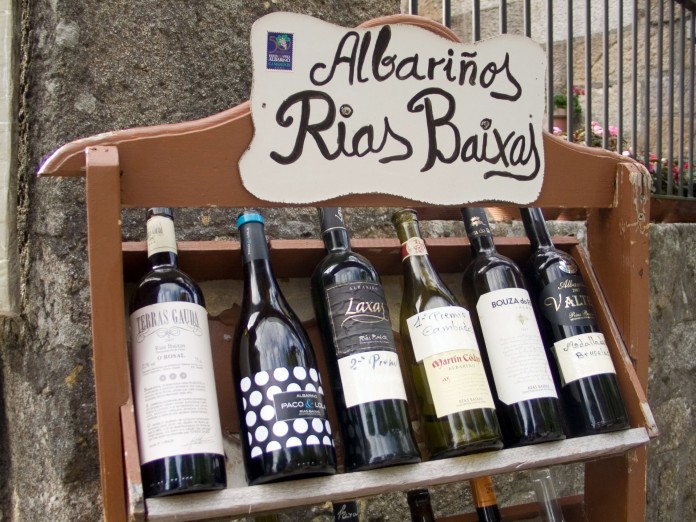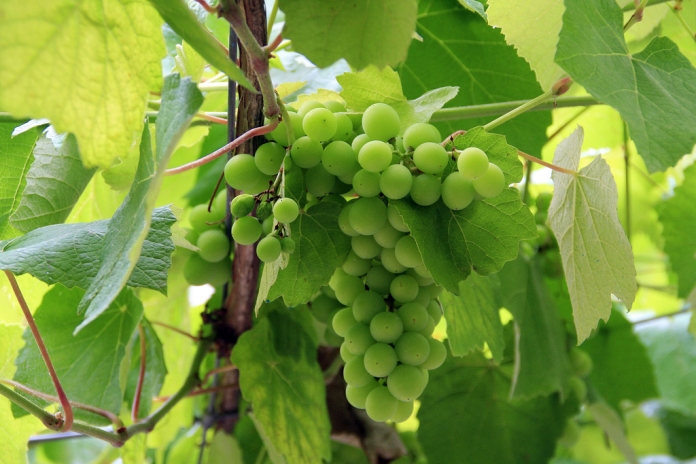Uno de los momentos de más orgullo gallego de toda mi vida ocurrió en un asiento de Business Class de British Airways volando hacia Pekín al ver en la carta de vinos un Albariño Sin Palabras de Adegas Castrobrey, Denominación de Origen Rías Baixas. Había sido seleccionado en una cata ciega por un comité de expertos y por el creador de los menús de Club World de BA, el chef Cass Titcombe, muy fan de los blancos gallegos y que siempre tiene otro Albariño (Serra da Estrela) en la carta de vinos de sus restaurantes Canteen de Londres.
No debería permitirse abandonar Galicia a ningún visitante mayor de edad que no haya probado al menos un Albariño, un Godello y un vino de Ribeiro. Uno de cada. El Albariño es un vino blanco seco que se cultiva en un suelo de granito y en el clima atlántico, húmedo y tibio de las Rías Baixas, con sus primaveras precoces y sus veranos anticiclónicos. La producción es limitada. El vino fragante y afrutado, ligero y delicioso, de baja graduación y sin crianza, con un olor un poco a albaricoque. La pareja perfecta para el marisco. En un panorama global dominado por la aburrida neutralidad de Chardonnays y Sauvignon Blancs, la personalidad del Albariño ha conquistado a los bebedores de blanco del mundo. Es el vino blanco español más vendido en Estados Unidos y a mediados de los noventa se plantaron las primeras vides de Albariño en el valle de Santa Inés de California.
La uva verde de Godello produce un zumo — No debería permitirse abandonar Galicia a ningún visitante mayor de edad que no haya probado al menos un Albariño, un Godello y un vino de Ribeiro. espeso que parece de kiwi y resulta en vinos equilibrados, de color amarillo paja y aromas afrutados a manzana. Los críticos (ese grupo especial de gente que no bebe vinos sino que cata caldos) se han rendido a sus encantos. Jancis Robinson del Financial Times ha metido en su lista de los Vinos Blancos Mejor Valorados del Mundo a dos Godellos de la denominación de origen Valdeorras: As Sortes y O Soro, ambos del 2011.
Pero mi vino blanco gallego favorito es el Ribeiro, quizá porque es la denominación con mas historia (lo mencionan los cronistas romanos en el siglo II a.C.), quizá porque usa las variedades de uva mas autóctonas (treixadura y torrontés) o quizá por ser más asequible que otros blancos. Producido en el oeste de Ourense en las
orillas (ribeiras) del Río Miño y sus afluentes, el Ribeiro es un vino de emperadores y reyes, el primer vino que llegó a América en los barcos de Colón y el vino gallego que entre el siglo XIV y el XVI se decantaba encantado en las mesas de la nobleza de Inglaterra, Italia y Flandes.
El Ribeiro pasó después por plagas y épocas oscuras, fue olvidado, se abandonaron las viñas autóctonas antiguas y en su lugar tras la Guerra Civil se plantó variedad Palomino (Alicante también le llamaban), que en Galicia produce cantidades de dudosa calidad. Es ese Ribeiro afrutado, popular y festivo que se vende en jarras y se bebe en tazas blancas de loza (fantástico con el pulpo á feira). Pero no es el bueno. El mejor, el autóctono, ha renacido con fuerza para recuperar su lugar en la historia y las mesas y manteles. Es un vino limpio y transparente, brillante a la luz, de tonos amarillos pálidos y pajizos y con frescos reflejos verdes. Sutil, complejo, con aromas de frutas y flores, balsámico y especiado. De magnifico paladar. Fino y delicado. Sabroso y aromático. Persistente y armónico. O eso es lo que dicen los expertos. Yo lo que sé es que tiene un maravilloso trago largo y que es increíble con una merluza blanca con ajada.
#7 The Whites
— Galicia, a user’s manual
One of the proudest moments of my life as a Galician man happened when, in a Business Class seat, in a British Airways flight to Beijing, I discovered an Albariño wine Sin Palabras from Castrobrey winery, P.O. Rías Baixas, in the winelist. It has been selected in a blind tasting by a commitee of experts and the creator of the menus of World Club of BA, the chef Cass Titcombe, a big fan of Galician white wines and who always has another Albariño (Serra da Estrela) in the winelist of his restaurants Canteen in London.
It should be forbidden that any visitor leave Galicia without having tried at least an Albariño, a Godello and a Ribeiro wine. One of each one. The Albariño is a dry white wine that is grown on a granite floor and in the Atlantic climate, warm and damp, of the Rias Baixas, with its early springs and its anticyclonic summers. The production is limited. The fragrant and fruity wine, light and delicious, low proof and without aging, with a little apricot smell. The perfect match for seafood. In an international scene dominated by the boring neutrality of the Chardonnays and Sauvignon Blancs, the Albariño’s personality has won over the world’s white wine drinkers. It is the Spanish best selling white wine in the United States and in the mid-nineties the first vines of Albariño were planted the Santa Ynez Valley of California.
The green Godello grape produces a thick green juice that seems kiwi juice and results in balanced wines, with yellow straw color and fruity aromas of apple. Critics (that special group of people who do not drink wines but tastes them) have surrendered to its charms. Jancis Robinson from the Financial Times has put on his list of the Year´s top whites two Godellos with D.O. Valdeorras: As Sortes and O Soro, both of 2011.
But my favorite Galician white is the Ribeiro, maybe because it is the D.O. with more history (Roman chroniclers mention it in the second century BC), maybe because it uses the most indigenous varieties of grape (treixadura and torrontés) or maybe because it is more affordable than other whites. Produced in western Ourense in the banks (ribeiras) of the Minho River and its tributaries, the Ribeiro is a wine of emperors and kings, the first wine that went to America on the ships of Columbus and also the Galician wine that, between the XVI and XVI century was decanted and delighted at the tables of the nobility of England, Italy and Flanders.
Later, the Ribeiro sufferered plagues and dark times, was forgotten, the ancient native vines were abandoned and in their place, the Palomino variety was planted (also called Alicante), which in Galicia produces quantities of dubious quality. Is that Ribeiro whichi is fruity, festive and popular, sold in jars and drunk in white china cups (great with octopus á feira style). But that is not the good one. The best, the native, has been strongly reborn to regain its place in history and in the tables and tablecloths. It is a clean, transparent wine, bright in the light, with pale and straw yellows and fresh green highlights. Subtle, complex, with aromas of fruits and flowers, balsamic and spicy. Magnificent in the palate. Fine and delicate. Tasty and aromatic. Persistent and harmonious. Or so the experts say. What I know is that it has a long and wonderful drink and it is incredible with a white hake with garlic sauce.

